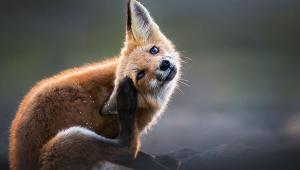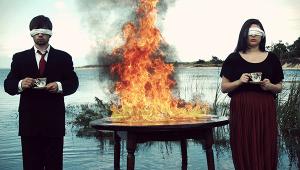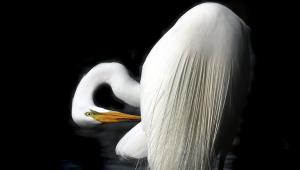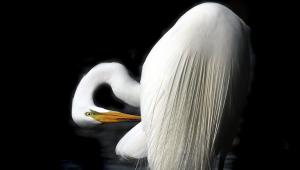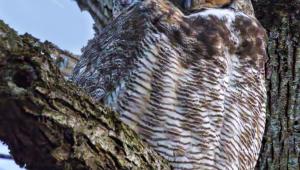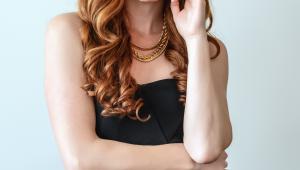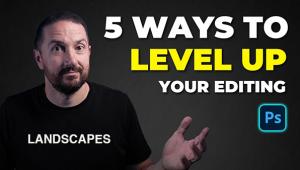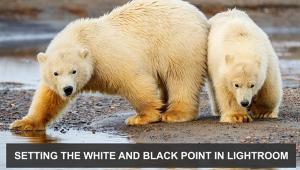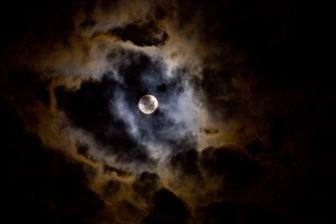Commercial Photographer Mark Holthusen’s Fantastical Images And Knack For The Latest Camera Tech Thrills Clients

“This is a product used by Olympic athletes to provide neurofeedback and improve their athletic skills. The question the client asked me was, how do we illustrate all this in a meaningful yet artistic way? My solution: we developed a stylistic theme for the product on set, which we carried through for the entire campaign.” Holthusen shot the model against white seamless, lighting with an Octabank above his head. He also used two Profoto heads through silks from front left and right, and two more washing the backdrop, plus fill cards. (Agency: JPG Creative.)
All Photos © Mark Holthusen
San Francisco-based commercial photographer Mark Holthusen is constantly reinventing himself, rarely sitting still, except for the occasional interview. When he’s not shooting ads for one client or another using the latest photo and video gear, he’s creating theatrical productions or embarking on personal, photojournalistic projects, always seeking new outlets for his creativity.
Starting Out
Holthusen’s interest in photography began at an early age. “I was an artistic kid, largely involved with sculpting,” Holthusen reminisced. “When I was 16, I attended the San Francisco Art Institute, where I studied sculpture but also became enamored with photography.” His first camera was the Pentax K1000, followed by a Canon T70.
“I went to Brooks Institute for a little while, which is where I started shooting 4x5.” He eventually bought a Horseman, followed shortly by a Hasselblad 500C, each with a normal lens.

Holthusen’s inventive nature helped expand on the client’s concept for this ad, resulting in a composite image featuring a high-key utopian setting. From his stock library, Holthusen used various waterfalls shot in Laos. Then came the tricky part. To achieve the consistency of a milky surface, he photographed a muddy pond, so it had a viscous texture and a tone to it. That let him convincingly transform it to milky white in Photoshop. “For the next stage, we had each of the models separately stand in a vat of fake milk, maybe four-foot square.” There was no wind machine for the female model. Instead, her hair was shot separately, with the model lying on a table. Lighting consisted of a big, open soft light and a fill card. (Agency: Goodby, Silverstein & Partners.)
Going Digital Early
Holthusen learned to appreciate digital very early on. “One of my first jobs (circa 1998 or 1999) was running the photo department at the San Francisco Examiner, on a freelance basis. It was right at the time when the photo industry was shifting to digital.” In an effort to promote the new technology, camera companies would shower the media with state-of-the-art digital cameras. “So the paper’s photographers were switching back and forth between film, which was scanned, and shooting on digital cameras.”
Around this time, the dot-com explosion occurred, coinciding with Holthusen’s formation of a catalog production company, with a business partner. They’d invested in one of Nikon’s digital progenitors, a Nikon D1, along with Speedotron studio strobes, to tackle all the products they’d shoot.
“We rented an airplane hangar at the Santa Monica Airport,” Holthusen recalled. “Clients would literally drop off 20,000 or 30,000 products for us to shoot. Because these items required fast turnaround for online posting, we set up an assembly line and a business model that was different from what photographers were doing at the time. These companies didn’t care what it looked like. They just needed it and needed it fast.” That lasted for several years, until the dot-com bubble burst.
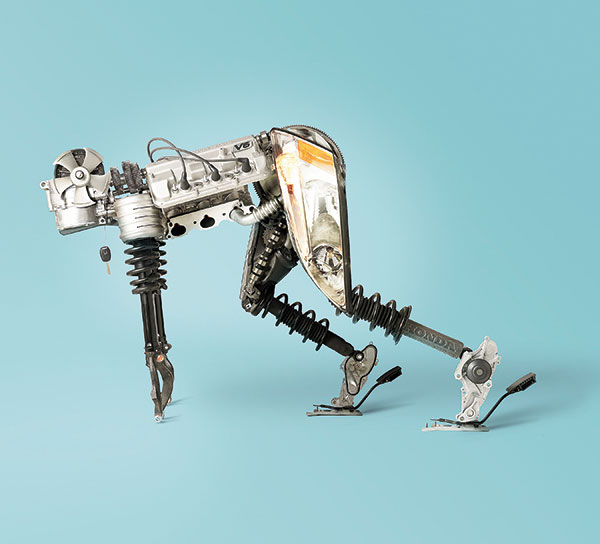
Honda wanted to illustrate speed in this ad campaign. “They asked me to go into a studio and just take a car and turn it into different objects.” Working in a huge rental studio with an L.A. car prep shop and a mechanic, they disassembled the vehicle supplied by the client and laid it out in rows, by shape, and slowly hand-built various robots. “It took a month to shoot three ads, devoting one week just to prep and arrange the parts.” Because there weren’t enough parts to go around for the arms and legs, they had to reshape some of the parts, which Holthusen shot separately, then composited into the shot. Lighting came from a softbox and fill cards, plus small spots for key areas that were also composited into the final image. The “robot” itself was suspended on C stands, which were retouched out. (Agency: RPA.)
Reinventing Himself (Again)
Working at that frenetic pace took its toll. Holthusen was burnt out and decided to reinvent himself yet again. “It was a great trial by fire. You learned to light any surface, any product.” Now it was time for a change.
Holthusen moved on to high-end digital postproduction in Adobe Photoshop, this time working for other photographers. “At the same time, I made a serious effort to get into advertising, namely shooting my own book (portfolio) and showing my work to potential clients.”
That path proved arduous and slow, but Holthusen already had one foot in the door. Postproduction introduced him to the right people. “Having my hand in creating large ad campaigns made potential clients more comfortable with me.” Still, that wasn’t enough for a firm foothold.

The requirements and layout for this shot, titled “Moogyver,” were unwavering. The entire series was based on television good-guy/bad-guy action shows. Holthusen shot this in a meat locker in Los Angeles. The entire image is a composite of numerous elements, down to the cow’s hooves. The cow consisted of a guy in a fat suit dressed MacGyver-fashion, a real cow’s head, and a wig. These components, including the final element, the cow (with the aid of a wrangler), were brought into the studio and shot separately. The cow was trained to stand on apple boxes, thereby raising its head so it could be properly lit and photographed from floor level. “We tried to put wigs on a cow, but that just did not work.” (Agency: Richards Group.)
“And then, in 2005, I ended up with a project photographing and designing for Roger Waters (an original member of the rock band Pink Floyd), for his opera Ça Ira, about the French Revolution.” This project allowed Holthusen to combine his talents in both sculpture and photography. “That was such a high-profile project that it catapulted me and got me firmly in the door with advertising clients.”
From this experience, a defining style emerged. For that theatrical production, Holthusen built miniatures, shot them, and then composited these images in Photoshop to create the backdrops used on stage. “In the ensuing years, I followed through on that as much as I could, honing the techniques in my advertising work.”

For this studio shot, Holthusen used a real sneaker, with an added resin insole to better reflect the light, which consisted of a Profoto spot aimed into the shoe from above (visible in the shot, but retouched out). A smoke machine added atmosphere and helped catch some light rays, which were then used as the basis for the retouching to generate the final look, with postproduction adding a grid reminiscent of the pattern on the shoe. The backdrop, from the photographer’s stock library, was later composited into the shot. (Agency: Isobar.)
Using The Latest Gear
Today, Holthusen largely works with Hasselblad and Canon. “I go back and forth between the two, depending on what I’m doing. If we’re on location and it’s people and things are moving fast, I use the Canon 5D Mark III. In the studio, I turn to the Hasselblad, currently the H4D-50.” He owns several lenses for each, with the normal lens being his go-to glass in each case. While he also shoots hand held, the tripod that accompanies him on location is a Gitzo carbon fiber with a Gitzo ball head.
Holthusen no longer owns his own studio, since the vast majority of his work takes him across the country and to all corners of the globe. Where needed, he rents studio space. For his lighting these days, he turns to Profoto, owning a D4 power pack system and the battery-powered B1 500 AirTTL, but renting overseas. Light-shaping gear extends to Elinchrom Octabanks (adapted to the Profotos) and American Grip butterfly flats with silks.
For his image processing and asset management, Holthusen works on Macs. His software includes Adobe Photoshop, Lightroom, and After Effects, along with Cinema 4D (www.maxon.net). He also brings an iMac with him on location, almost always shooting tethered.

This was part of a long-running campaign. The client came to Holthusen with concepts for him to flesh out, using his unique vision, in collaboration with the AD. “These were really fun to do, because they’re different from the typical advertising project.” The shot was composited. The train itself was shot in Roanoke, Virginia, at an old train museum, whereas the photo of the station was taken in Portland, Oregon. Holthusen photographed the talent, handmade luggage (built to scale around the toilet, the featured product), and props in the studio. (Agency: GSD&M.)
Adding Video To The Mix
One signature assignment was a long-running ad campaign for Kohler, where Holthusen put all his talents to work in creating some very inventive scenarios, often with a quirky twist. Theatrical productions continue to be a mainstay, but he’s also added video to the mix. In addition to his still gear, Holthusen employs the Red cinema camera (www.red.com), which plays a part in animated productions and music videos.
He added: “I get uncomfortable if I’m not doing something. If I’m not working on a commercial project or theatrical production, I try to do something for myself.” His personal projects often involve portraiture outside the mainstream. “This allows me to meet new people and experience new ways of life, and gives me a rare glimpse into people’s lives that one does not ordinarily see.”
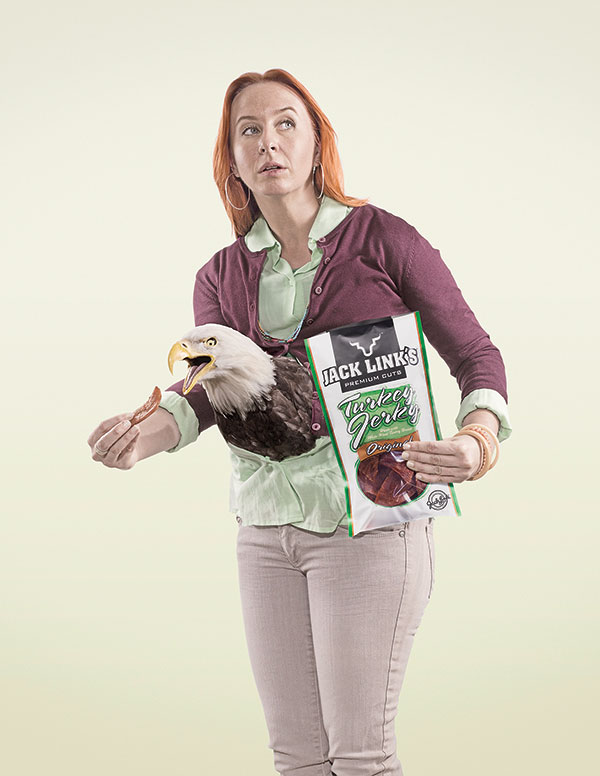
“The campaign revolved around feeding your hunger, and they wanted to represent that with various predatory animals shown in this fashion.” The backdrop is a light-gray seamless, “which I often prefer, instead of white, so I get a little tone in it.” The eagle and other wildlife used in the campaign were made by Legacy Effects (www.legacyefx.com), a special effects studio in Los Angeles. These were animatronic, originally created for the TV commercials. The eagle was strapped to her convincingly enough so it appeared to be emerging from her body. Two Profoto Magnums were aimed through silks on either side of her to get a soft yet edgy look, with a couple of heads on the background from left and right for a clean wash of light. (Agency: Carmichael Lynch.)
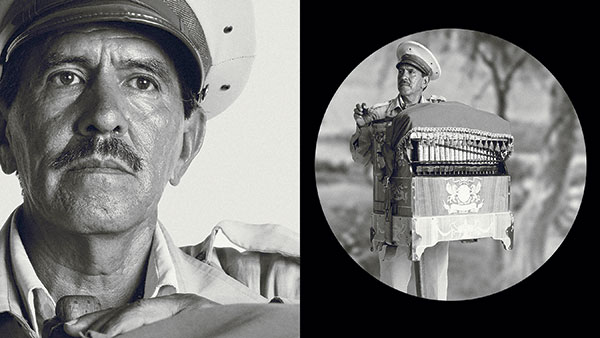
Holthusen approaches many of his personal projects in a purely photojournalistic fashion, uncomplicated by postproduction. These often involve portraits of people doing what they love or practicing their craft. “These organ grinders are a dying art, centered in Mexico City. We found an entryway of a big theater, which I used with permission. We set up a small studio on the fly, with an Octabank and beauty dish.” The lights were rented from a local production company.
To view more of Mark Holthusen’s still and video work, visit his website, www.markholthusen.com.
- Log in or register to post comments











